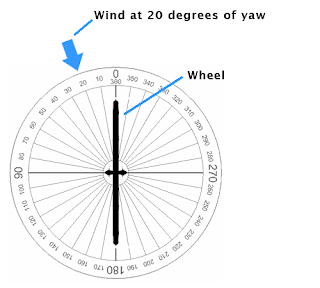Whether you’re a seasoned triathlete dialed in to every last detail of your aero position, a road cyclist eager to upgrade your ride, or a gravel grinder looking for an edge on those windy backroads, understanding how different wheel depths affect handling is key. In many parts of the cycling world, deep-section wheels are prized for their aerodynamic benefits. They cut through the air, reduce drag, and can shave valuable minutes off your time trial or triathlon split. However, the aerodynamic game is not as simple as “deeper equals faster” in every scenario. Crosswinds, especially, add a level of complexity that makes wheel depth choice more nuanced.
One of the more technical but crucial aspects of wheel aerodynamics is the concept of center of pressure. The “center of pressure” is the point where the resultant aerodynamic force acts on the wheel. This point changes depending on the wheel’s rim depth, shape, and the direction of the wind (or “yaw angle”). In this post, we’ll explore why having a shallower rim in the front and a deeper rim in the back can shift this center of pressure rearward—and why that matters so much for handling in real-world conditions.
What is Yaw Torque?
Before diving into the center of pressure, let’s talk about yaw torque, which we discussed in detail in Episode #57 of the FLO Aerodynamics Podcast. Yaw torque refers to the twisting force you feel on your handlebars when wind hits your bike from the side. Imagine riding on a gusty day: you feel your handle bars wanting to turn or pivot under you. That’s yaw torque at work.
- Yaw Angle: The angle between your direction of travel and the apparent wind.
- Torque: A rotational force. The closer to the bike’s pivot point (your steering axis) the wind force is acting, the more torque you feel.
When the front wheel experiences a large side force, you have to counteract it with your arms and upper body to keep the bike going straight. This is especially pronounced if the center of pressure (where the wind effectively “pushes” on the wheel) is close to the steering axis.

Center of Pressure: The Aerodynamic “Sweet Spot”
In many ways, the center of pressure acts like the balancing point of aerodynamic forces on your wheel. Think about how you might balance a ruler horizontally on your finger: where you place your finger is like the center of pressure for that system. If it’s too far forward, the front end dips; too far back, the back end dips. For bicycle wheels, when the center of pressure is closer to the front axle, you feel more steering input (i.e., more yaw torque). When it’s shifted rearward, that yaw torque on the handlebars is reduced.
How Rim Depth Affects the Center of Pressure
Deep-section wheels are designed to reduce drag by smoothing airflow around the rim and tire interface. That’s why they excel in time trials and triathlons—they can significantly lower your aerodynamic drag in steady wind conditions. However, their deeper profile also means they present a larger surface area to side winds, which can result in a more forward center of pressure on your front wheel if both wheels are equally deep.
On the other hand, using a shallower rim up front and a deeper rim in the back shifts this center of pressure toward the rear. Here’s why:
- Shallower Front Wheel: A shallower rim front wheel has less side area for crosswinds to push against. That naturally reduces the magnitude of the aerodynamic force acting on the front wheel.
- Deeper Rear Wheel: The deeper rear wheel can handle stronger side winds without creating steering instability because, in the back, it’s not connected to the steering axis. Any sideways push on the rear wheel doesn’t directly twist the handlebars.
- Overall Effect: By reducing the front wheel’s side force and increasing the rear wheel’s side force, the net center of pressure moves backward, away from your handlebars. As a result, you feel less yaw torque and more stable handling, especially in gusty conditions.

Why This Matters for Triathletes
Triathletes are often most concerned about aerodynamic drag because every second on the bike leg translates directly to finish times. However, an overly aggressive choice of a deep front wheel can lead to coming out of the aero bars when the wind picks up. In triathlon, especially in long-course events like IRONMAN, the ability to stay tucked in the aerobars consistently is a major key to success. Fighting your front wheel for hours on end is both mentally and physically draining.
By selecting a slightly shallower front wheel—say a Flo 64 AS—in combination with a deeper rear wheel—like our FLO 77 AS—you still gain the aerodynamic benefits while minimizing the risk. You’ll retain control, stay in the aerobars longer, and come off the bike ready to run. It’s that simple: a stable ride often saves more time over the entire course than a slightly more aerodynamic but far less controllable setup.
Benefits for Road Cyclists
Road racers and everyday road cyclists can enjoy these benefits just as much as triathletes. Handling is a prime concern on group rides and in road races, where you’re not only dealing with crosswinds but also the turbulence created by other riders, vehicles, or even roadside features. A more stable bike means:
- Confidence on Fast Descents: Many road races feature hilly terrain with high-speed descents. Strong crosswinds on a descent can be unnerving, so a setup that keeps the bike balanced is a huge plus.
- Easier Cornering: Taking tight corners in windy conditions can be tricky. With the center of pressure moved rearward, you have less wrestling to do with the handlebars, allowing more precise corner entry and exit.
- Reduced Fatigue: When you’re not fighting your front wheel, you save energy. In a race scenario, energy spent fighting the wind is energy not spent on your pedals in the final sprint.
Gravel and Adventure Riding
Gravel racing and adventure riding continue to explode in popularity. With the adventurous courses in these disciplines—often complete with open fields or high plains—wind can be a considerable factor. While gravel wheels don’t typically go as deep as pure aero road wheels, our G700 and G650 are 55mm and 59mm deep respectively. In these conditions, the same principle holds:
- Shallower Front, Deeper Rear: Helps keep the bike calmer when the wind is whipping over open farmland or wide gravel stretches.
- Stability on Varied Terrains: Gravel often means looser surfaces, ruts, and rocks. A calmer front wheel helps you navigate these obstacles with precision and confidence.
- Comfort Over Long Distances: Gravel events are known for their epic distances and challenging terrain. Not having to constantly wrestle your handlebars keeps you fresher for the long haul.
Practical Tips for Choosing Wheel Depth
- Assess Your Riding Conditions: If you frequently ride in very windy regions or on exposed roads, opt for a shallower front wheel like our FLO 49 AS or FLO 64 AS, paired with a deeper rear wheel like our FLO 64 AS, FLO 77 AS or FLO DISC.
- Mind Your Weight and Bike Fit: Heavier riders and well-balanced bike fits are typically more stable. Lighter riders or those riding a very aggressive position may feel crosswinds more acutely, making a shallower front even more beneficial.
- Test in Real-World Conditions: Every cyclist has their own reaction to the wind. We’ve outfitted 230 lbs men on our shallowest wheels and 100 lbs women on our deepest wheels. You will know how you feel in wind so let that be your guide when selecting wheels.
- Remember Tire Width and Pressure: Wheel depth is only one part of the puzzle. Matching tire width to the internal rim width and using optimal tire pressure can also affect handling.
- Aerodynamic Gains vs. Confidence: The fastest wheel in a wind tunnel isn’t always the fastest wheel on the road. Confidence and control often result in faster overall riding, especially over long distances.
Final Thoughts
Shifting the center of pressure rearward by using a shallower front and deeper rear wheel is an elegant solution to the age-old trade-off between aerodynamic efficiency and ride stability. This setup reduces the yaw torque on your handlebars, making it easier to stay aero and relaxed—two key factors that translate into better performance whether you’re chasing a podium at your next triathlon, pushing the pace on a group ride, or tackling a gravel epic with friends.
As we’ve discussed in our Aero Wheel Tutorial and on FLO Aerodynamics Podcast Episode #57, aerodynamics is not a one-size-fits-all proposition. Your choice of wheels should align with your riding style, typical routes, race goals, and comfort level. For many triathletes, the sweet spot is a mid-depth front (FLO 64 AS) and a deeper rear (FLO 77 AS). For road cyclists and gravel enthusiasts, similar principles apply, but you might adjust rim depths for specific course profiles or personal preference.
In the end, the ideal setup is the one that enables you to ride both fast and with confidence. By understanding how the center of pressure affects your handling, you’ll be better equipped to choose wheels that let you focus on your performance, rather than fighting the wind. Ride safe, ride smart, and keep pushing those limits.

Co-founder at FLO Cycling. Jon manages the day to day operations and acts as the lead engineer for all FLO products.
